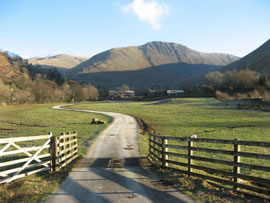Why is Hartsop special?
Hartsop is a small historic hamlet located on a historic route from the Patterdale Valley up onto the high fells with attractive architectural and historic character. This includes:

- Many buildings with architectural and historic quality, 12 of which are grade II listed buildings, and many others which make a positive contribution to the area’s historic character and appearance
- Buildings predominantly date from the 17th century and are good examples of the vernacular tradition
- Vernacular features displayed within the hamlet include stepped gables, circular chimneys and 'spinning galleries'
- Developed as Low Hartsop, probably in the medieval period
- Principal period of settlement growth dates from the late 16th and 17th centuries, as a series of scattered farmsteads for statesmen farmers
- Various industries associated with the hamlet and the immediate surrounding area: corn milling; wool trade; stone and slate quarrying and metal mining
- Rural location on the banks of the Pasture Beck, with the greater part of the settlement lying on the north side
- Principal route through the settlement is a narrow track which connects with a series of footpaths and bridleways across the fells, including the Roman road, the High Street
- Hamlet lies between two historic crossing points of the Pasture Beck, the 17th century pack horse bridge, Pasture Beck Bridge, and a ford
- Significant long views through the conservation area to high peaks, such as Hartsop Dodd, and further long views along the Patterdale Valley
- Tightly clustered dispersed settlement of farms and houses arranged predominantly around a central meandering lane
- Historic inbye fields, and later fields enclosed by the 19th century, form an important part of the landscape setting of the hamlet
- Buildings orientated to face onto the lane and arranged as detached houses, some with farm buildings attached under the same roof
- Palette of building materials reflects the underlying geology, carboniferous limestone, and Lake District slates
- Limestone rubble, sometimes with a limewash coat, used for domestic buildings
- Boundary walls of exposed limestone and cobbles
- Wide grass verges and fields enhance the relationship between Hartsop and the surrounding landscape
- Important areas of native hedgerow, individual trees and tree groups link the hamlet to the wider countryside, such as the significant historic woodland Low Wood, on the west side of the Patterdale Valley.
More details
